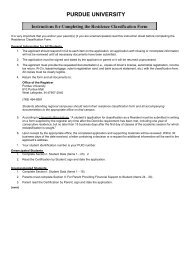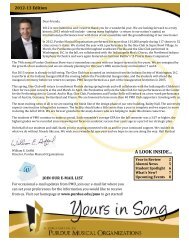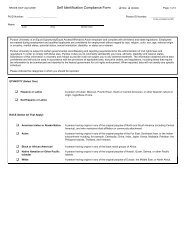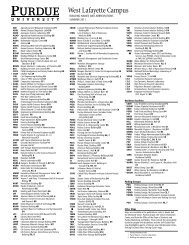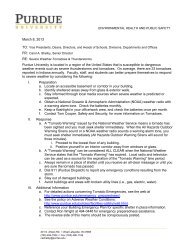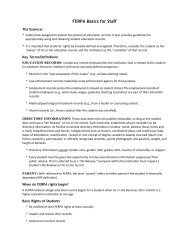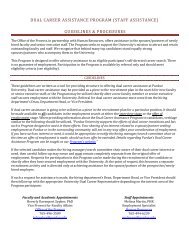PURDUE UNIVERSITY INFECTIOUS DISEASE PLAN
PURDUE UNIVERSITY INFECTIOUS DISEASE PLAN
PURDUE UNIVERSITY INFECTIOUS DISEASE PLAN
Create successful ePaper yourself
Turn your PDF publications into a flip-book with our unique Google optimized e-Paper software.
<strong>PURDUE</strong> <strong>UNIVERSITY</strong> <strong>INFECTIOUS</strong> <strong>DISEASE</strong> <strong>PLAN</strong><br />
Version 2<br />
July 2, 2012<br />
Emergency Preparedness and Planning Office<br />
Terry Memorial House<br />
205 South Martin Jischke Drive<br />
West Lafayette, IN 47907<br />
(765) 494-0446<br />
<strong>PURDUE</strong> <strong>UNIVERSITY</strong><br />
CAMPUS EMERGENCY PREPAREDNESS & <strong>PLAN</strong>NING OFFICE
<strong>PURDUE</strong> <strong>UNIVERSITY</strong> Version 2<br />
<strong>INFECTIOUS</strong> <strong>DISEASE</strong> <strong>PLAN</strong><br />
TABLE OF CONTENTS<br />
<strong>INFECTIOUS</strong> <strong>DISEASE</strong> <strong>PLAN</strong><br />
Section 1: Plan Fundamentals .............................................................................3<br />
Section 2: Phases of Emergency Management ...................................................5<br />
Section 3: Concept of Operations ........................................................................7<br />
Section 4: Organizational Resources ...................................................................8<br />
Section 5: Acronyms and Definition of Terms ......................................................9<br />
APPENDICES<br />
APPENDIX 1 – ISDH Reportable Instances<br />
APPENDIX 2 – ISDH Confidential Report of Communicable Diseases<br />
2
<strong>PURDUE</strong> <strong>UNIVERSITY</strong> Version 2<br />
<strong>INFECTIOUS</strong> <strong>DISEASE</strong> <strong>PLAN</strong><br />
Section 1: Plan Fundamentals<br />
1.1 Purpose<br />
A) The purpose of the Purdue University Infectious Disease Plan (IDP) is to provide<br />
basic procedures, resources, and guidance in preventing, preparing, and<br />
responding to communicable disease outbreaks (i.e., meningitis, tuberculosis)<br />
and more emergent infectious diseases (i.e., pandemic influenza).<br />
B) The Infectious Disease Plan provides a general description of the process in<br />
which an infectious disease would be controlled on the Purdue University<br />
campus. These procedures are subject to change on a case by case basis to<br />
best minimize the morbidity and mortality of Purdue population.<br />
1.2 Scope<br />
A) The resources and strategies outlined in this plan are designed to give<br />
assistance to students, faculty and staff at the Purdue University main campus.<br />
B) The primary stakeholders involved in managing infectious disease situations<br />
may include Purdue University Student Health (PUSH) and Purdue Campus<br />
Emergency Preparedness & Planning Office in accordance with the Tippecanoe<br />
County Health Department (TCHD) and the Indiana State Department of Health<br />
(ISDH). Planning, preparation, and response to a severe infectious disease<br />
emergency (i.e., pandemic influenza) will require additional collaboration with<br />
the Purdue University Public Health Emergency Committee.<br />
1.3 Laws, Policies and Authorities<br />
A) Purdue University’s Infectious Disease Plan will follow the laws, policies, and<br />
standards given by the federal, state, and local governments in accordance with<br />
Purdue University’s integrity and values. Such laws considered include the<br />
Health Insurance Portability and Accountability Act (HIPAA) and State and<br />
Federal laws giving public health officials the authority to act during a public<br />
health emergency.<br />
B) Federal and State Laws:<br />
1) Federal Civil Defense Act, as amended (50 USC 2251 et seq.), 1950<br />
2) Defense Authority Act 1977 (PL 94-361)<br />
3) Superfund Amendment and Reauthorization Act (also known as the<br />
Emergency Planning and Community Right to Know Act), PL 99-499, 1986<br />
4) Robert T. Stafford Disaster Relief and Emergency Assistance Act, PL 100-<br />
707, as amended (42 USC 5131 et seq.), 1988<br />
5) United States Code, Title 42, Public Health and Welfare<br />
6) Chapter 68, Disaster Relief<br />
7) Health and Human Services: Health and Information Privacy<br />
3
<strong>PURDUE</strong> <strong>UNIVERSITY</strong> Version 2<br />
<strong>INFECTIOUS</strong> <strong>DISEASE</strong> <strong>PLAN</strong><br />
1.4 Situation<br />
8) Code for Federal Regulations: Title 45-Public Welfare and Human Services<br />
9) Chapter 9: Communicable Disease: Imposition of Restrictions on<br />
Individuals with Certain Communicable Diseases<br />
A) The infectious disease plan may be activated when a student, staff, or faculty<br />
member tests positive to a reportable communicable disease. Incidents that<br />
qualify to activate the infectious disease plan include pandemic influenza,<br />
tuberculosis, meningitis, and hepatitis among others. (For a full list of<br />
reportable infectious diseases, see Appendix 1). If necessary, the Tippecanoe<br />
County Health Department (TCHD) may work alongside Purdue University<br />
Student Health (PUSH) and other relevant Purdue University entities to ensure<br />
the infected individuals are informed and the risk of infection to others is<br />
minimized.<br />
1.5 Assumptions<br />
A) The infectious disease is reportable to ISDH (see Appendix 1)<br />
B) The infectious disease is transmittable from human to human<br />
C) The transmission of the disease will impose a significant risk of morbidity<br />
D) The infectious disease transmission can be minimized by using prevention,<br />
preparation, and response strategies<br />
4
<strong>PURDUE</strong> <strong>UNIVERSITY</strong> Version 2<br />
<strong>INFECTIOUS</strong> <strong>DISEASE</strong> <strong>PLAN</strong><br />
Section 2: Phases of Emergency Management<br />
2.1 The phases listed below are general responses to a public health emergency<br />
involving an infectious disease outbreak at the Purdue University campus (See<br />
Figure 1). Strategies such as providing education to the community, raising<br />
awareness of infectious disease resources and plans, and responding and<br />
recovering to an infectious disease outbreak will vary due to the severity of an<br />
outbreak, the current resources available, and the decisions made amongst the<br />
Purdue University stakeholders to best fit the response to situation.<br />
Figure 1: Phases of Emergency Response<br />
2.2 Prevention and Mitigation (Educate prevention strategies to reduce the risk of<br />
contracting and spreading infectious diseases.)<br />
A) Primary Prevention (Stop infectious diseases before they happen):<br />
1) Wash hands regularly<br />
2) Keep up-to-date on vaccinations<br />
3) Receive regular medical examinations<br />
4) Maintain a healthy diet<br />
5) Exercise regularly<br />
6) Get an adequate amount of sleep<br />
7) Maintain proper hygiene<br />
8) Drink plenty of water<br />
9) Find healthy ways to reduce stress<br />
B) Secondary Prevention (Keep infectious diseases from getting worse):<br />
1) Seek medical attention as necessary (See Section 4 for hospitals in your<br />
area)<br />
2) Comply to your medical regimen as advised by your doctor<br />
3) Reduce spread of disease to others<br />
4) Drink plenty of water<br />
5
<strong>PURDUE</strong> <strong>UNIVERSITY</strong> Version 2<br />
<strong>INFECTIOUS</strong> <strong>DISEASE</strong> <strong>PLAN</strong><br />
5) Maintain a healthy diet<br />
6) Get an adequate amount of sleep<br />
2.3 Preparation (Gain knowledge regarding infectious disease information in your<br />
area):<br />
A) Keep up to date on infectious disease outbreaks around Purdue University<br />
B) Review all organizational resources available to you<br />
1) (See Section 5: Organizational Resources)<br />
2.4 Response (Possible responses by the TCHD & PUSH to reduce the spread of<br />
infection. For more detailed response information go to Section 4: Concept of<br />
Operations)<br />
A) Analysis and surveillance of infectious disease outbreak<br />
B) Dissemination of information and education to the public<br />
C) Take all appropriate measures to reduce the spread of infection among the<br />
Purdue community<br />
2.5 Recovery (Potential recovery strategies to improve the health of the Purdue<br />
Community):<br />
A) Re-evaluation of preparation and response strategies to reduce the spread of<br />
infectious diseases<br />
B) Continue to re-evaluate community health education strategies to inform the<br />
Purdue community of infectious disease risks<br />
6
<strong>PURDUE</strong> <strong>UNIVERSITY</strong> Version 2<br />
<strong>INFECTIOUS</strong> <strong>DISEASE</strong> <strong>PLAN</strong><br />
Section 3: Concept of Operations<br />
Figure 2: Concept of Operations*<br />
A Purdue University resident that tests<br />
positive (both active and latent cases) for a<br />
reportable communicable disease will be<br />
reported to ISDH and the Tippecanoe<br />
County Health Department (TCHD). Upon<br />
notification, the TCHD may inform PUSH<br />
and obtain information from the infected<br />
individual if seen necessary. Dependant<br />
on the severity of the disease and the risk<br />
associated with spreading the disease, the<br />
TCHD and PUSH will work together on a<br />
variety of levels to ensure the safety of the<br />
Purdue community.<br />
The basic concept of operations (See<br />
Figure 2) is created to show what may<br />
happen if a Purdue Resident is tested for<br />
an infectious disease. These operations<br />
are subject to change on a case by case<br />
basis at any point in time. Infectious<br />
diseases that are applicable for TCHD<br />
involvement and the information needed by<br />
the TCHD can be viewed in Appendix 1 &<br />
Appendix 2 respectively.<br />
* Concepts of operation are subject to change<br />
** For applicable infectious diseases see Appendix 1<br />
*** For information that may be needed see Appendix 2<br />
Situations of higher risk (i.e., TB, food handlers with highly communicable infectious<br />
disease) may warrant further measures if the patient is incompliant to their medical<br />
regimen or exposing others to high risk disease. Such heightened measures may<br />
include direct observation therapy, self-isolation, testing to individuals in close<br />
proximity, and potentially local law enforcement involvement. (For laws supporting<br />
these measures, see Section 2: Laws, Policies, and Authorities)<br />
7
<strong>PURDUE</strong> <strong>UNIVERSITY</strong> Version 2<br />
<strong>INFECTIOUS</strong> <strong>DISEASE</strong> <strong>PLAN</strong><br />
Section 4: Organizational Resources<br />
4.1 Lafayette Hospitals<br />
‣ Saint Elizabeth Regional Health<br />
1501 Hartford Street,<br />
Lafayette, IN 47904<br />
(765) 423-6011<br />
Map and Locations<br />
4.2 Purdue University Resources<br />
‣ Purdue University Student Health<br />
601 Stadium Mall Dr.<br />
West Lafayette, IN 47907<br />
(765) 494-1700<br />
‣ Clarian Arnett Hospital<br />
5165 McCarty Ln.<br />
Lafayette, IN 47905<br />
(765) 448-8000<br />
Map and Locations<br />
‣ Purdue Campus Emergency<br />
Preparedness & Planning Office<br />
‣ Purdue ALERT<br />
‣ Emergency Procedures Handbook<br />
4.3 Health Departments<br />
‣ Indiana State Department of Health<br />
2 North Meridian Street<br />
Indianapolis, IN 46204<br />
(317) 233-1325<br />
Map and Locations<br />
Twitter: ISDH_DHS<br />
‣ Tippecanoe County Health<br />
Department (TCHD)<br />
629 N. 6th Street<br />
Lafayette, IN 47901<br />
(765) 423-9221<br />
Map and Locations<br />
4.4 Additional Resources<br />
‣ Centers for Disease Control and Prevention<br />
Facebook: CDC<br />
Twitter: CDCEmergency<br />
‣ World Health Organization<br />
Twitter: WHONEWS<br />
8
<strong>PURDUE</strong> <strong>UNIVERSITY</strong> Version 2<br />
<strong>INFECTIOUS</strong> <strong>DISEASE</strong> <strong>PLAN</strong><br />
Section 5: Acronyms and Definition of Terms<br />
5.1 Acronyms:<br />
CDC<br />
HIPAA<br />
IDP<br />
ISDH<br />
PU<br />
PUSH<br />
SARS<br />
TB<br />
TCHD<br />
WHO<br />
Centers for Disease Control and Prevention<br />
Health Information Portability and Accountability Act<br />
Infectious Disease Plan<br />
Indiana State Department of Health<br />
Purdue University<br />
Purdue University Student Health<br />
Severe Acute Respiratory Syndrome<br />
Tuberculosis<br />
Tippecanoe County Health Department<br />
World Health Organization<br />
5.2 Definitions<br />
Active Cases: An infectious disease that can spread from the infectious individual<br />
to others.<br />
Communicable Disease: A disease that is able to transmit from human to<br />
human.<br />
Direct Observation Therapy: Direct observation by a medically trained<br />
professional to ensure the patient is adhering with recommended medical<br />
protocols.<br />
Health Information Portability and Accountability Act (HIPAA): A federal law<br />
protecting the privacy of an individual by making personal records confidential.<br />
For more information visit: http://www.hhs.gov/ocr/privacy/<br />
Hepatitis: A liver disease caused that ranges in severity based on the type of<br />
virus. For more information visit: http://www.cdc.gov/hepatitis/index.htm<br />
Latent Cases: A case in which an individual has the disease, but is not able to<br />
infect others with it.<br />
Law Enforcement Involvement: An incident in which an individual with a serious<br />
communicable disease refuses to comply with recommended measures may be<br />
subjected to LE involvement to ensure the public’s safety.<br />
Meningitis: A disease causing inflammation of the brain and spinal cord. Severity<br />
of illness can range based on the cause of the infection.<br />
For more information visit: http://www.cdc.gov/meningitis/index.html<br />
Morbidity: A state of illness due to a disease or medical condition.<br />
9
<strong>PURDUE</strong> <strong>UNIVERSITY</strong> Version 2<br />
<strong>INFECTIOUS</strong> <strong>DISEASE</strong> <strong>PLAN</strong><br />
Mortality: Death due to a disease or a medical condition.<br />
Outbreak: An event in which an infectious disease has spread in a localized area.<br />
Pandemic Influenza: A novel strain of the flu virus that sustains transmission of<br />
the disease globally.<br />
For more information visit: http://www.pandemicflu.gov/<br />
Primary Prevention: Prevention strategies that stop a disease from happening<br />
before it starts.<br />
Self-Isolation: Additional measures to reduce the spread of the infectious disease<br />
by isolating the infected individual.<br />
For more information visit: Indiana Bench Book Update: Isolation and Quarantine<br />
Testing to Individuals in Close Proximity: Individuals that reside in close<br />
proximity to an individual with a serious highly communicable disease may be<br />
offered a screening test in order to reduce further spread of the illness.<br />
Tuberculosis (TB): A condition in which bacteria called mycobacterium<br />
tuberculosis attacks the lungs.<br />
For more information visit:<br />
10
<strong>PURDUE</strong> <strong>UNIVERSITY</strong> Version 2<br />
<strong>INFECTIOUS</strong> <strong>DISEASE</strong> <strong>PLAN</strong><br />
APPENDICES<br />
APPENDIX 1 – ISDH Reportable Instances<br />
11
<strong>PURDUE</strong> <strong>UNIVERSITY</strong> Version 2<br />
<strong>INFECTIOUS</strong> <strong>DISEASE</strong> <strong>PLAN</strong><br />
APPENDIX 2 – Confidential Report of Communicable Diseases<br />
12





